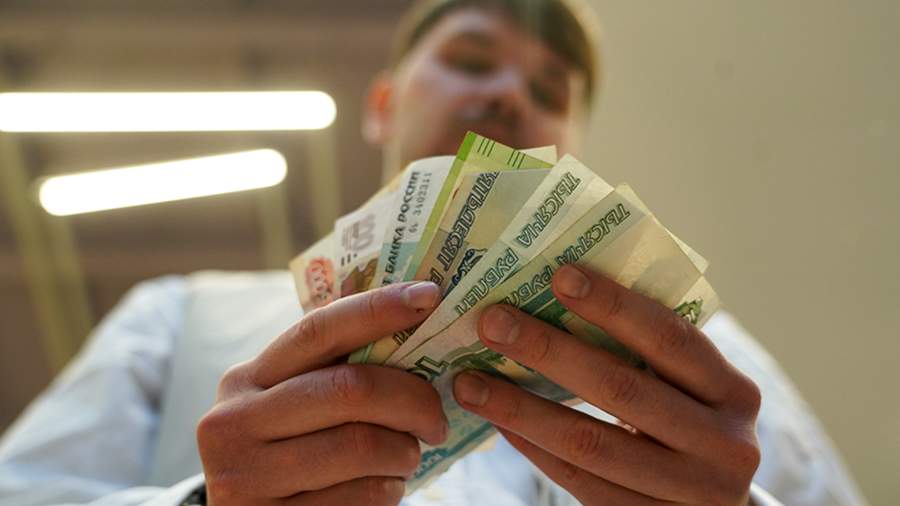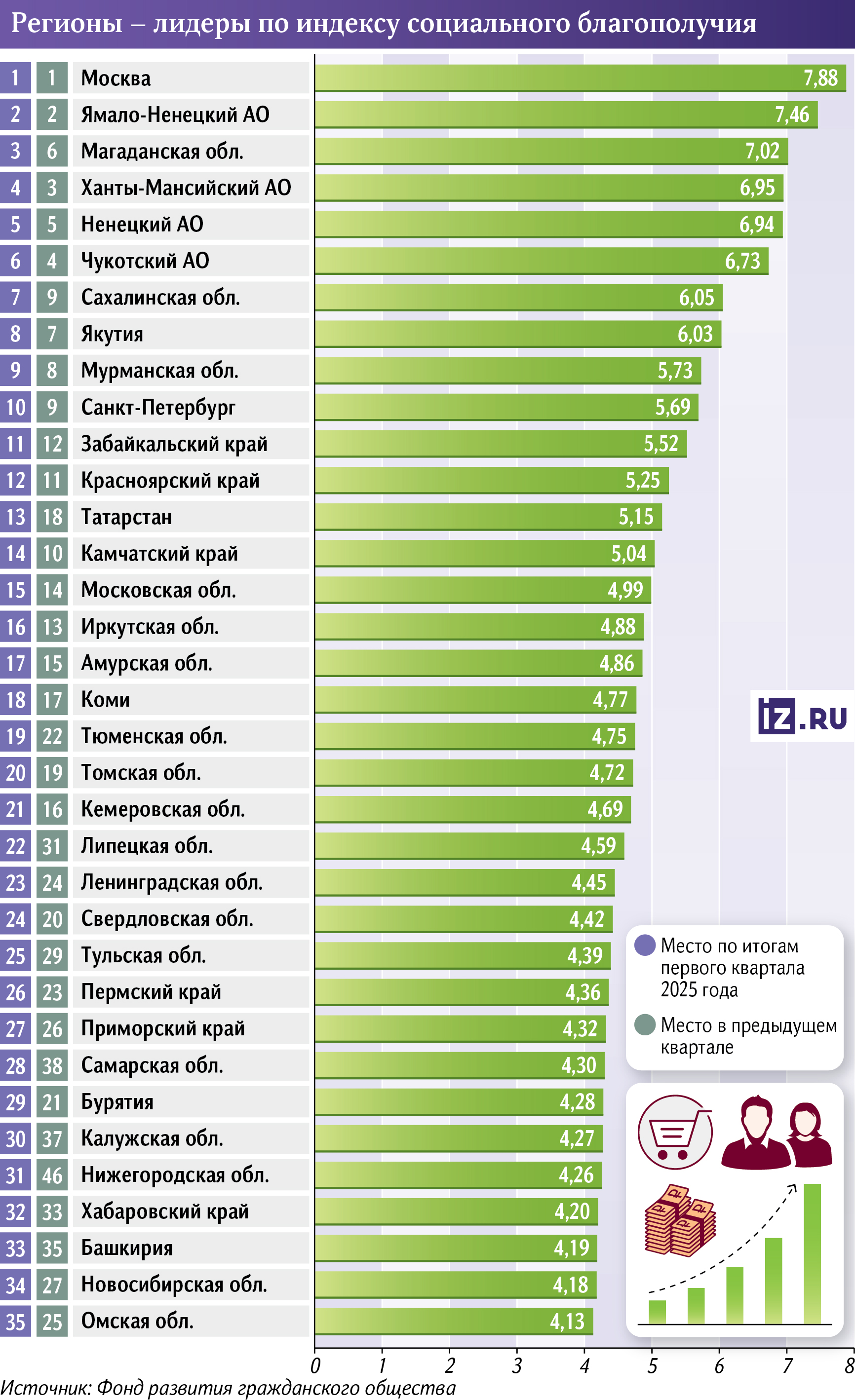Multiplication table: the index of social well-being among Russians increased by 12 over the year%
- Статьи
- Society
- Multiplication table: the index of social well-being among Russians increased by 12 over the year%

The index of social well-being among Russians has grown by 12% over the year, according to a study by FoRGO. According to analysts, the average monthly salary in the country increased by 24%, while the cost of living increased by 10.2% over the same period. The top ten regions according to the social well-being index, according to the study, included Moscow, the Yamalo-Nenets Autonomous District, the Magadan Region, the Khanty-Mansi Autonomous Okrug, the NAO, Chukotka, the Sakhalin Region, Yakutia, the Murmansk Region and St. Petersburg.
In which regions of Russia is the welfare of Russians growing
The index of social well—being of Russians (the average salary to the average cost of living) increased by 12% over the year - as of January 1 this year to January 1, 2024. Such data is provided in the FoRGO study "Index of social well-being. Top 35". The document is available to Izvestia.
"The dynamics of this indicator in the whole country from 2016 to the beginning of 2025 does not demonstrate dependence on external factors (CBOs, sanctions), but rather shows its absence. There is a steady trend towards a steady increase in this index," the document says.
It also notes that the average monthly salary in Russia as a whole at the beginning of 2025 amounted to 128,665 rubles. Compared to the corresponding period last year, it increased by 24% from 103,815 rubles, which led to an increase in the index of social well-being, the authors of the study explain.
At the same time, the average cost of living (a fixed set of goods and services excluding the cost of housing and utilities), according to Rosstat, increased from 21.5 thousand to 23.8 thousand rubles (+10.2%) over the same period.
 .
.
As of February 2, Moscow, the Yamalo-Nenets Autonomous District, the Magadan Region, the Khanty-Mansi Autonomous Okrug, the NAO, Chukotka, the Sakhalin Region, Yakutia, the Murmansk Region and St. Petersburg entered the top ten of the top 35 regions according to the index of social welfare. The second group includes the Trans—Baikal and Krasnoyarsk Territories, Tatarstan, Kamchatka Territory, Moscow, Irkutsk, Amur Regions, Komi, Tyumen and Tomsk regions. The third group included Kemerovo, Lipetsk, Leningrad, Sverdlovsk, Tula Regions, Perm and Primorsky Territories, Samara Region, Buryatia and Kaluga Region.
The Nizhny Novgorod Region, Khabarovsk Territory, Bashkiria, Novosibirsk and Omsk regions complete the study.
"Moscow continues to occupy a leading position, as its economy has a sufficient margin of safety and potential to maintain income growth ahead of inflation," Konstantin Kostin, head of FoRGO, explained to Izvestia.
According to him, compared to the results of the fourth quarter of 2024, the most noticeable changes in the rating (more than three positions up) were recorded in Tatarstan (+5) — it moved from 18th to 13th place; Tyumen Region (+3) — from 22nd to 19th. Lipetsk Region (+9) — from 31st to 22nd place; Tula Region (+4) - from 29th to 25th place; Samara Region (+10) — from 38th to 28th place; Kaluga Region (+7) — from 37th to 30th place; Nizhny Novgorod Region (+15) — from 46th to 31st place.
According to FoRGO, this was primarily due to an increase in average monthly salaries relative to the cost of a fixed set of goods and services.
What influences the income growth of Russians
The fact that real wages and real incomes have been rising among Russians over the past two years is an obvious fact, said Georgy Ostapkovich, director of the HSE Center for Economic Studies.
— This is certainly a very positive signal. First of all, salary increases are noted in the extractive industry and defense enterprises, which now have a significantly increased workload. In addition, incomes are growing for all ITS participants. For example, a person received 40,000 rubles while working at a factory, went on a special operation, and his monthly income is already 200,000 rubles, plus millions of bonuses in the form of one—time payments," the expert explained to Izvestia.
According to him, salaries are also increasing in those areas where there is a shortage or shortage of workers, such as food delivery couriers. At the same time, he noted that there are industries in Russia where salaries are not growing or even declining. For example, in the production of clothing, dressmakers today receive only 40 thousand rubles.
As for the subjects that are represented in the rating, their positions, according to Georgy Ostapkovich, are quite logical. Most of the top ten are represented by oil-producing regions. If we talk about Moscow and St. Petersburg, these are cities of federal importance with significant resources and innovative potential, therefore, the index of social well-being there is significantly higher than in other Russian cities, the expert noted.
Konstantin Kalachev, head of the Political Expert Group, agrees with this opinion.
— The fact that Moscow is the leader is absolutely indisputable. Of course, I would suggest looking at not only the average salary, but also the median salary. But in any case, the growth of well-being is determined by the trend towards an increase in income. The real disposable incomes of Russians increased by 8.5% in 2024. This was announced by Prime Minister Mikhail Mishustin, speaking in the State Duma with a report on the work of the Cabinet of Ministers following the results of last year, the expert explained to Izvestia.
As for prices, not everything is getting more expensive, the expert noted. For example, smartphone prices have dropped in Russia this year, he added. And the dollar exchange rate in the Russian Federation continues to remain well below its "standard" levels.
According to Konstantin Kalachev, if we talk about the regions, then the Yamalo—Nenets Autonomous District, Khanty-Mansi Autonomous Okrug, Sakhalin are the traditional leaders. Due to the absence of logistics problems, as well as high competition in the retail market, Moscow offers maximum opportunities to meet consumer demand. In addition, the dynamics of the capital's development significantly exceeds the average level of development of other regions, and the incomes of Muscovites are now higher than those of residents of hydrocarbon—supplying regions, the expert noted.
Переведено сервисом «Яндекс Переводчик»
